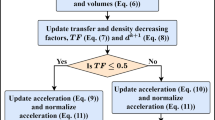Abstract
As the calculation of the exact position and orientation of the end effector of robot manipulator is mandatory to obtain inverse kinematics solution, an artificial neural network is used to obtain inverse kinematics as it reduces the computational time as well as complexity associated. The backpropagation algorithm that is generally used for updating weights and biases requires the sensitivity function of the system which is sometimes difficult to obtain. Here, training of neural network means optimizing the parameters of neural network, i.e. weights and biases, for which particle swarm optimization (PSO) is used. PSO is suitable for learning neural network as it does not require the derivative of an objective function. In this work, the parameters of neural networks, i.e. weights and biases, are optimized using three different optimization algorithms, i.e. PSO, segmented particle swarm optimization (SPSO) and modified segmented particle swarm optimization (MSPSO), and their results are then compared. Further, a comparison has been made on the basis of two parameters, i.e. fitness function and regression, and MSPSO is found to perform better than the other two optimization algorithms. Fitness function value obtained using MSPSO is 6.18e−09, using SPSO is 1.1e−05 and using PSO is 2.35e−03.



















Similar content being viewed by others

Abbreviations
- ANN:
-
Artificial neural network
- PSO:
-
Particle swarm optimization
- SPSO:
-
Segmented particle swarm optimization
- MSPSO:
-
Modified segmented particle swarm optimization
References
P.K. Mahapatra, S. Sethi, A. Kumar, Comparison of artificial immune system and particle swarm optimization techniques for error optimization of machine vision based tool movements. J Inst Eng India Ser C 96(4), 363–372 (2015). https://doi.org/10.1007/s40032-015-0181-1
P.K. Kamaliya, Y.K.D. Patel, Kinematic modeling and function generation for non-linear curves using 5R double arm parallel manipulator. J Inst Eng India Ser C 97(1), 33–40 (2016). https://doi.org/10.1007/s40032-015-0199-4
S. Alavandar, M.J. Nigam, Neuro-fuzzy based approach for inverse kinematics solution of industrial robot manipulators. Int J Comput Commun Control 3(3), 224–234 (2008)
Kinoshita K, Watanabe K, Isshiki M, Estimation of inverse model based on ANN and PSO with adaptively varying acceleration coefficients. In: 2014 Proceedings of the SICE annual conference (SICE). IEEE, pp 281–286
Aghajarian M, Kiani K (2011) Inverse kinematics solution of PUMA 560 robot arm using ANFIS. In: 2011 8th international conference on ubiquitous robots and ambient intelligence (URAI), pp 574–578. IEEE
M. Ayyıldız, K. Çetinkaya, Comparison of four different heuristic optimization algorithms for the inverse kinematics solution of a real 4-DOF serial robot manipulator. Neural Comput Appl 27(4), 825–836 (2016)
M. Bayati, Using cuckoo optimization algorithm and imperialist competitive algorithm to solve inverse kinematics problem for numerical control of robotic manipulators. Proc Inst Mech Eng Part I J Syst Control Eng 229(5), 375–387 (2015)
P. Badoni, Neural network based inverse kinematics solution for 6-R robot using Levenberg–Marquardt algorithm. Int J Sci Eng Res 3(11), 79–83 (2014)
Csiszar A, A combinatorial approach to the automated generation of inverse kinematics equations for robot arms. In: 2016 IEEE international conference on automation science and engineering (CASE). IEEE, pp 984–989
Chen J, Lau HY, Inverse kinematics learning for redundant robot manipulators with blending of support vector regression machines. In: 2016 IEEE workshop on advanced robotics and its social impacts (ARSO). IEEE, pp 267–272
Jha P, Biswal BB (2014) Hybrid neural network based prediction of inverse kinematics of robot manipulator. In: 5th International design and research conference. IIT, Guwahati
Cui Y, Takahashi K, Hashimoto M, Design of control systems using quaternion neural network and its application to inverse kinematics of robot manipulator. In: 2013 IEEE/SICE international symposium on system integration (SII). IEEE pp. 527–532
R. Köker, C. Öz, T. Çakar, H. Ekiz, A study of neural network based inverse kinematics solution for a three-joint robot. Robot Auton Syst 49(3), 227–234 (2004)
S. Manjaree, V. Agarwal, B.C. Nakra, Inverse kinematics using neuro-fuzzy intelligent technique for robotic manipulator. Int J Adv Comput Res 3(4), 160 (2013)
N. Mohammadi, S.J. Mirabedini, Comparison of particle swarm optimization and backpropagation algorithms for training feed forward neural network. J Math Comput Sci 12, 113–123 (2014)
S.K. Nanda, S. Panda, P.R.S. Subudhi, R.K. Das, A novel application of artificial neural network for the solution of inverse kinematics controls of robotic manipulators. Int J Intell Syst Appl 4(9), 81 (2012)
R. Song, X. Chen, C. Shen, H. Zhang, Modeling FOG drift using back-propagation neural network optimized by artificial fish swarm algorithm. J Sens 2014, 273043 (2014)
K. Thanushkodi, K. Deeba, A new improved particle swarm optimization algorithm for multiprocessor job scheduling. Int J Comput Sci Issues 8(4), 230–234 (2011)
X. Yan, Q. Wu, H. Liu, W. Huang, An improved Particle swarm optimization algorithm and its application. Int J Comput Sci 10(1), 316–324 (2013)
T. Rangaswamy, S. Vidhyashankar, M. Madhusudan, H.R.B. Shekar, Performance parameters analysis of an XD3P peugeot engine using artificial neural networks (ANN) concept in MATLAB. J Inst Eng India Ser C 96(2), 175–182 (2015). https://doi.org/10.1007/s40032-014-0140-2
A. S. Jaber, A. Z. Ahmad, A. N. Abdalla. A new parameters identification of single area power system based LFC using Segmentation Particle Swarm Optimization (SePSO) algorithm. 2013 IEEE PES Asia-Pacific power and energy engineering conference (APPEEC), 8–11 December 2013. IEEE. https://doi.org/10.1109/APPEEC.2013.6837264
Author information
Authors and Affiliations
Corresponding author
Additional information
Publisher's Note
Springer Nature remains neutral with regard to jurisdictional claims in published maps and institutional affiliations.
Rights and permissions
About this article
Cite this article
Shastri, S., Parvez, Y. & Chauhan, N.R. Inverse Kinematics for A 3-R Robot Using Artificial Neural Network and Modified Particle Swarm Optimization. J. Inst. Eng. India Ser. C 101, 355–363 (2020). https://doi.org/10.1007/s40032-019-00539-5
Received:
Accepted:
Published:
Issue Date:
DOI: https://doi.org/10.1007/s40032-019-00539-5



